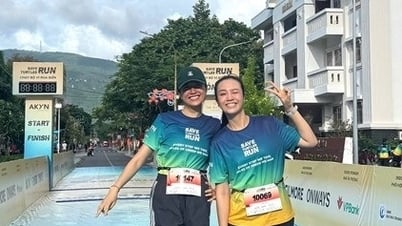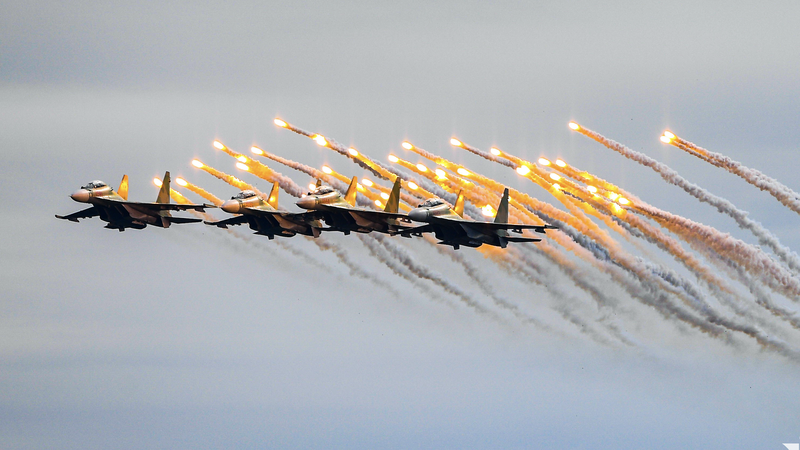However, many people have difficulty breathing while running, especially beginners. Shortness of breath, hip pain or premature exhaustion often come from incorrect breathing, according to the health website Verywell Health .
According to Aubrey Bailey, a physical therapist in the US, mastering and practicing correct breathing techniques not only helps improve running performance but also helps runners run further, longer and more safely.

Many people have difficulty breathing while jogging, especially beginners.
Photo: AI
Abdominal breathing (diaphragmatic breathing)
One of the basic techniques to practice is abdominal breathing, also known as diaphragmatic breathing.
Many people have the habit of breathing shallowly and quickly when running, which causes air to only enter the upper part of the lungs, not utilizing the full capacity of the lungs.
Meanwhile, belly breathing helps bring air in from the bottom up, using the diaphragm to pull air deep into the lungs. When inhaling, the diaphragm drops, the abdomen expands. This breathing method helps increase the amount of oxygen supplied to the muscles, supporting the removal of carbon dioxide from the body. As a result, runners can move more effectively, feel less tired and improve the stability of the midsection.
Breathe in rhythm
In addition, regulating your breathing with your steps is also an important factor. This technique is called rhythmic breathing, which helps synchronize your breathing with each running step.
Many people tend to breathe in a 2-2 rhythm, which means inhaling for 2 steps and exhaling for the next 2 steps. However, this method causes runners to always exhale when their foot lands on the same side, which can easily put pressure on one side of the body and increase the risk of injury.
Experts recommend trying a 3-2 breathing pattern, which means inhaling for 3 steps and exhaling for 2 steps, alternating which side you land on when exhaling, which helps reduce pressure on your joints.
Breathe through your nose or mouth
Another important point is knowing when to breathe through your nose and when to breathe through your mouth.
Breathing through your nose helps filter the air, increasing your intake and getting more oxygen into your blood. However, breathing through your nose while running can make you feel out of breath, especially when you first start.
Runners should practice nasal breathing while walking or jogging to gradually adapt their bodies.
When running fast or climbing hills, the need for oxygen increases, at this time breathing through the mouth is necessary to provide enough air for the muscles to work.
Correct breathing technique will be more effective if combined with proper running posture.
Runners should keep their shoulders relaxed, their body leaning slightly forward, and their weight evenly distributed over their feet. The legs, hips, back, neck, and head should be in a straight line. The arms should be slightly bent at 90 degrees and swing in the opposite direction of the stepping leg to create balance.
Note if you have prolonged shortness of breath or chest pain when jogging.
During training, if the runner has applied the correct breathing techniques but still has difficulty improving performance, he should consider finding a professional coach for specific guidance.
If you experience symptoms such as persistent shortness of breath, chest pain or dizziness, see your doctor to check for underlying health problems, such as exercise-induced asthma or heart or lung disease.
Source: https://thanhnien.vn/meo-giup-tho-de-dang-hon-khi-chay-bo-185250712103606287.htm



![[Photo] The first meeting of the Cooperation Committee between the National Assembly of Vietnam and the National People's Congress of China](https://vphoto.vietnam.vn/thumb/1200x675/vietnam/resource/IMAGE/2025/8/31/f5ed4def2e8f48e1a69b31464d355e12)
![[Photo] National Assembly Chairman Tran Thanh Man welcomes and holds talks with Chairman of the National People's Congress of China Zhao Leji](https://vphoto.vietnam.vn/thumb/1200x675/vietnam/resource/IMAGE/2025/8/31/9fa5b4d3f67d450682c03d35cabba711)
![[Photo] General Secretary To Lam receives Chairman of the National People's Congress of China Zhao Leji](https://vphoto.vietnam.vn/thumb/1200x675/vietnam/resource/IMAGE/2025/8/31/5af9b8d4ba2143348afe1c7ce6b7fa04)
![[Photo] Marching together in the hearts of the people](https://vphoto.vietnam.vn/thumb/1200x675/vietnam/resource/IMAGE/2025/8/31/8b778f9202e54a60919734e6f1d938c3)
























































































Comment (0)